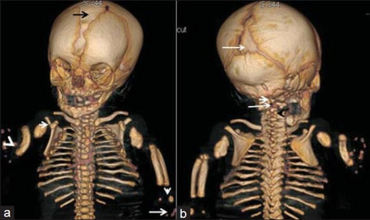Chondrodysplasia, Grebe type
| Chondrodysplasia, Grebe type | |
|---|---|
 | |
| Reconstruction skeletal CT scan a) Opened anterior fontanel arrow as well as, defective development of shoulder girdle, dysplastic lateral parts of the clavicles, aplasia of glenoids arrow, aplasia of radius white arrowhead b) opened posterior fontanel white arrow, ill-defined cranio-cervical junction white arrow, fusion of posterior arches C3-C4 arrowhead | |
| Specialty | Medical genetics |
| Symptoms | Dwarfism, Dysmelia |
| Causes | GDF5 gene mutation |
| Diagnostic method | Exome sequencing, clinical symptoms |
| Frequency | Lua error in Module:PrevalenceData at line 5: attempt to index field 'wikibase' (a nil value). |
Chondrodysplasia Grebe type is a rare genetic disorder. It is caused by a mutation to the GDF5 gene. This mutation may be inherited in an autosomal recessive pattern.[1]
Signs and symptoms
Chondrodysplasia Grebe type causes both dwarfism and dysmelia (short limb deformity).[2][3] It may also cause dental problems.[3] There is significant phenotypic variability between individuals.[2]
Cause
Chondrodysplasia Grebe type is caused by a mutation to the GDF5 gene.[4] It is inherited in an autosomal recessive pattern.[2][3] Because of this, 60% of people with chondrodysplasia Grebe type have consanguinous parents.[3]
Diagnosis
Due to the small number of signs and symptoms, and rarity, chondrodysplasia Grebe type is hard to diagnose.[2] Genetic testing, usually exome sequencing, is used to identify the mutation to the GDF5 gene.[5]
Treatment
Currently this condition has no available management[6]
References
- ↑ "Chondrodysplasia, Grebe type | Genetic and Rare Diseases Information Center (GARD) – an NCATS Program". rarediseases.info.nih.gov. Archived from the original on 18 March 2021. Retrieved 14 April 2021.
- ↑ 2.0 2.1 2.2 2.3 Langer, L. O.; Cervenka, J.; Camargo, M. (March 1989). "A severe autosomal recessive acromesomelic dysplasia, the Hunter-Thompson type, and comparison with the Grebe type". Human Genetics. 81 (4): 323–328. doi:10.1007/BF00283684. ISSN 0340-6717. PMID 2703235. S2CID 27942659. Archived from the original on 2021-05-25. Retrieved 2021-11-01.
- ↑ 3.0 3.1 3.2 3.3 Hattab, F. N.; Al-Khateeb, T.; Mansour, M. (1996-05-01). "Oral manifestations of severe short-limb dwarfism resembling Grebe chondrodysplasia: Report of a case". Oral Surgery, Oral Medicine, Oral Pathology, Oral Radiology, and Endodontology. 81 (5): 550–555. doi:10.1016/S1079-2104(96)80045-X. ISSN 1079-2104. PMID 8734701. Archived from the original on 2021-04-17. Retrieved 2021-11-01.
- ↑ Genovesi, Maria Luce; Guadagnolo, Daniele; Marchionni, Enrica; Giovannetti, Agnese; Traversa, Alice; Panzironi, Noemi; Bernardo, Silvia; Palumbo, Pietro; Petrizzelli, Francesco; Carella, Massimo; Mazza, Tommaso; Pizzuti, Antonio; Caputo, Viviana (2021-03-01). "GDF5 mutation case report and a systematic review of molecular and clinical spectrum: Expanding current knowledge on genotype–phenotype correlations". Bone. 144: 115803. doi:10.1016/j.bone.2020.115803. hdl:11573/1493515. ISSN 8756-3282. PMID 33333243. S2CID 229315625. Archived from the original on 2021-11-03. Retrieved 2021-11-01.
- ↑ "Chondrodysplasia, Grebe Type - Tests - GTR - NCBI". www.ncbi.nlm.nih.gov. Archived from the original on 2021-04-14. Retrieved 2021-04-14.
- ↑ Lang, Florian (19 March 2009). Encyclopedia of Molecular Mechanisms of Disease. Springer Science & Business Media. p. 343. ISBN 978-3-540-67136-7. Archived from the original on 16 January 2022. Retrieved 15 January 2022.